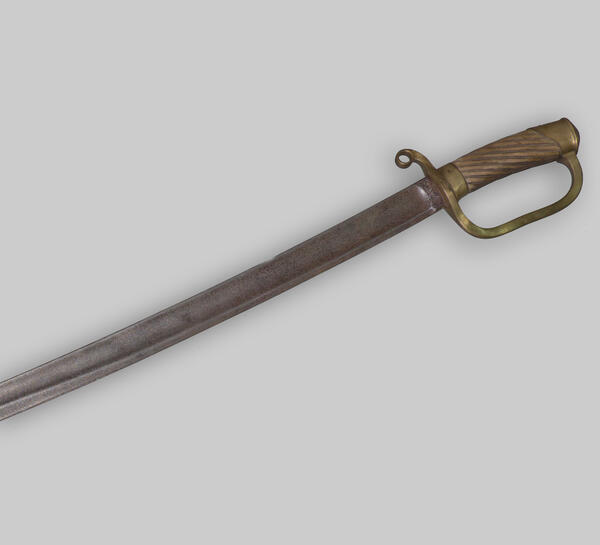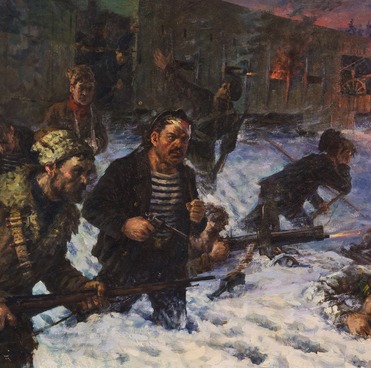In 1881, the Russian army carried out an armament reform under the leadership of Lieutenant General Alexander GorlOv. Its goal was to establish a single model of edged weapons for all types of troops, which became the sabre. The Caucasian blade was chosen as a standard for the sabre blade.
The sabre replaced cavalry, dragoon and infantry sabers and cuirassier broadswords for all the officers and generals to whom they were assigned. However, in 1882, the privileged Russian regiments – four cuirassier guards and two hussar guards – were allowed to keep broadswords and sabers for wearing in peacetime in full dress.
The dragoon soldier sabre, presented in the exposition of the BereznikI Museum, was found by Boris Nechaev - student 3 ‘V’ of the BereznikI School No. 2 named after Maxim Gorky. The schoolboy was going to visit his grandmother along the street of NagOrnaya in UsOlye village, when he noticed a part of the hilt of a sabre protruding from under the snow on a cliff under a stone. The boy brought his finding to the museum.
The sabre is an easy-to-handle weapon. In battle, it makes powerful chopping blows that are difficult to dodge or close. When fighting the soldiers made powerful chopping blows with the sabre that were hard to block or escape. Due to the peculiarities of balancing, it was more difficult to apply thrusting blows with a sabre. In order to master this art, the officers attended advanced courses. One of the main advantages of a single-type sabre of the late 19th century was cheap production and maintenance.
The sabre handle had a head and a handguard to protect the hand from the enemy’s weapons. Zlatoust arms factory brand is stamped on the handguard of the blade, under the stamp there is the year of the weapon’s manufacture - ‘1908’. The handle is wooden, with longitudinal inclined grooves. There is a carved metal sleeve with an oval flat head on.
The handguard is formed by a front bow extending from the upper part of the handle and smoothly merging into the crosspiece. The end of the crosspiece has a hole, is slightly bent down and rounded. There is a carved metal sleeve on the lower part of the handle.
In 1909, the sabre holder was slightly changed. The inclination of the handle increased, and its middle part thickened. The grooves on the handle have become transverse and deeper. A floral ornament and a monogram of the emperor appeared on the upper sleeve, during the reign of which the owner of the weapon was granted the first officer’s rank. The head of the handle was made in the form of a figured rosette.
The sabre replaced cavalry, dragoon and infantry sabers and cuirassier broadswords for all the officers and generals to whom they were assigned. However, in 1882, the privileged Russian regiments – four cuirassier guards and two hussar guards – were allowed to keep broadswords and sabers for wearing in peacetime in full dress.
The dragoon soldier sabre, presented in the exposition of the BereznikI Museum, was found by Boris Nechaev - student 3 ‘V’ of the BereznikI School No. 2 named after Maxim Gorky. The schoolboy was going to visit his grandmother along the street of NagOrnaya in UsOlye village, when he noticed a part of the hilt of a sabre protruding from under the snow on a cliff under a stone. The boy brought his finding to the museum.
The sabre is an easy-to-handle weapon. In battle, it makes powerful chopping blows that are difficult to dodge or close. When fighting the soldiers made powerful chopping blows with the sabre that were hard to block or escape. Due to the peculiarities of balancing, it was more difficult to apply thrusting blows with a sabre. In order to master this art, the officers attended advanced courses. One of the main advantages of a single-type sabre of the late 19th century was cheap production and maintenance.
The sabre handle had a head and a handguard to protect the hand from the enemy’s weapons. Zlatoust arms factory brand is stamped on the handguard of the blade, under the stamp there is the year of the weapon’s manufacture - ‘1908’. The handle is wooden, with longitudinal inclined grooves. There is a carved metal sleeve with an oval flat head on.
The handguard is formed by a front bow extending from the upper part of the handle and smoothly merging into the crosspiece. The end of the crosspiece has a hole, is slightly bent down and rounded. There is a carved metal sleeve on the lower part of the handle.
In 1909, the sabre holder was slightly changed. The inclination of the handle increased, and its middle part thickened. The grooves on the handle have become transverse and deeper. A floral ornament and a monogram of the emperor appeared on the upper sleeve, during the reign of which the owner of the weapon was granted the first officer’s rank. The head of the handle was made in the form of a figured rosette.



